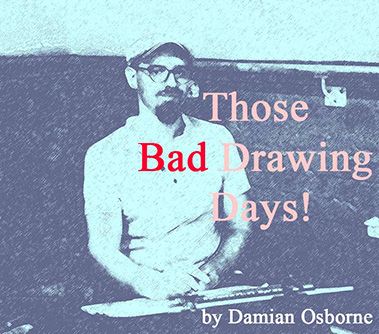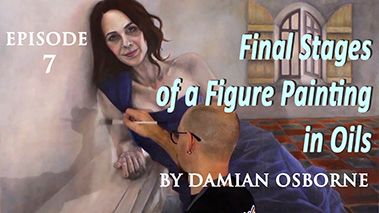Why I Love Realistic Figurative Paintings by Damian Osborne Realistic figurative painting has always fascinated me. When I look back through my old art history books and remember which artists and paintings were my favourites as a young, budding artist, figurative oil paintings felt especially vivacious, expressive, inspirational and powerful. And perhaps the genre of realistic figurative painting will always captivate me. For the language of the body speaks to us in an instinctive, primal way. As humans, we divine meanings and feelings through poses, postures and expressions that spoken words can not convey. Perhaps it’s because we…

What is Gesture Drawing?
What is Gesture Drawing? by Damian Osborne Gesture drawing is quick, free flowing, simplified sketching of the human form. The drawing sessions are usually timed from 30 seconds to 2 minutes. They are normally done from a live model, hence the term ‘life drawings’. Usually, the model is in the nude, as this allows the artist to really observe and study the anatomy of the human form. Gesture drawing practice Gesture drawing practice is the basis for artists learning to draw the human figure. It is the practice of drawing from life, not photos. You can’t…

Those Bad Drawing Days
Those Bad Drawing Days by Damian Osborne Yup, it’s a bad drawing day. Those days when you just want to stab the paper with your pencil, or press so hard with your charcoal that it breaks. You grimace and shake your head. You keep tearing out pages and tossing them behind you. Why can’t I get anything right? Why does her face look like it was smooshed by a bus? And why do her hands look like claws? Her eyes look like they can see each other; her legs look like penne pasta. Have you ever felt like…

Final Stages of a Figurative Painting – Painting the Figure – Part 4
Watch this video on YouTube Final Stages of a Figurative Painting Painting the Figure – Part 4 by Damian Osborne Figurative painting has become the main ‘body’ of my work. This painting is part of my Siren Series, where I depict a female figure in isolation before the sea. If you missed the last blog, I started working on painting the skin tone. In this chapter, I complete this figurative painting with several stages of glazing. What are two different techniques for figurative oil painting? Artists who paint the figure in oils can usually be divided into…

Painting the Skin Tone – Painting the Figure – Part 3
Watch this video on YouTube Painting the Skin Tone Painting the Figure – Part 3 by Damian Osborne There are many styles, colour palettes and methods artists present and past used for painting the skin tone, and of course it won’t do to just mix a universal ‘flesh colour’. Although I like to study as much of the old masters and their palettes as I can, as well as living artists’ methods, colour mixing is pretty intuitive for me; I’m thinking more in terms of colour temperature and value than following someone else’s method, rules, or anything else.…

Painting the Halftones – Painting the Figure – Part 2
Watch this video on YouTube Painting the Halftones Painting the Figure – Part 2 by Damian Osborne So, what are halftones in oil painting exactly? After I painted the grisaille (or ‘dead layer’) in the first chapter of this series, I was left with a cool grey, almost bluish skin tone because of the cooling effect white has over the raw umber imprimatura. So now I need to consider the values (light and dark), the colour hues (what actual local colours I need for the skin tones), and what colour temperatures I want to use for the skin,…

Painting the Figure – Part 1
Watch this video on YouTube Painting the Figure – Part 1 by Damian Osborne This painting is actually part of my Siren Series. I have broken up this figure painting demo into 4 parts. So stay tuned for explanations of the various stages. How do you start a figure painting with charcoal? Vine charcoal is the best medium for starting a figure painting because it’s easy to wipe away and make corrections to your drawing. It is also perfect for drawing on canvas. Unlike graphite, it is soft, and does not create the typical graphite sheen that…

Final Stages of a Figure Painting in Oils
Watch this video on YouTube Final Stages of a Figure Painting in Oils by Damian Osborne Usually when I’m working on a figure painting in oils, I write down ideas I have about the painting and the next steps I should follow. So once the painting is dry after a few days, I can pick up from where I left off. My journal becomes quite important near the final stages of the painting, because this is when things really start coming together, and I want to be sure I’m getting things right and not forgetting stuff. I also…

Painting the Traditional Way – Part 3 – The Dead Layer
Painting the Traditional Way – Part 3 – The Dead Layer by Damian Osborne After completing the underdrawing in charcoal, and going over the lines with a burnt sienna imprimatura, it was time to refine the anatomy and work on the ‘dead layer’ or underpainting stage. Refining the underpainting (the anatomy) In the next step, I started refining the underpainting a little more. Using burnt sienna, raw umber and some ultramarine blue, I refined the drawing of the woman’s anatomy, paying special attention to her spine and scapular, the trapezius muscle of the back, the buttocks and…

The Sirens 2019 – 2020
What do Sirens Symbolise? The Sirens represent the estranged wildness we may feel in the presence of untameable nature; the salty ocean wind lashing our face, the crushing fear of being dashed against rocks, of drowning, of being vulnerable, of being alive — the luring song of the unknowable. Click on an image to view I painted this series of figurative oil paintings between 2019 – 2020. The Sirens symbolise our disconnect with the mystical, savage and timeless nature of our unconscious. I have written quite extensively in The Siren Paintings on their symbolism, my…

